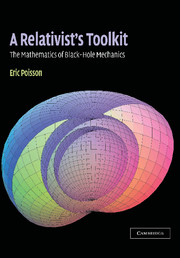3 - Hypersurfaces
Published online by Cambridge University Press: 02 December 2009
Summary
This chapter covers three main topics that can all be grouped under the rubric of hypersurfaces, the term designating a three-dimensional submanifold in a fourdimensional spacetime.
The first part of the chapter (Sections 3.1 to 3.3) is concerned with the intrinsic geometry of a hypersurface, and it examines the following questions: Given that the spacetime is endowed with a metric tensor gαβ, how does one define an induced, three-dimensional metric hab on a specified hypersurface? And once this three-metric has been introduced, how does one define a vectorial surface element that allows vector fields to be integrated over the hypersurface? While these questions admit straightforward answers when the hypersurface is either timelike or spacelike, we will see that the null case requires special care.
The second part of the chapter (Sections 3.4 to 3.6) is concerned with the extrinsic geometry of a hypersurface, or how the hypersurface is embedded in the enveloping spacetime manifold. We will see how the spacetime curvature tensor can be decomposed into a purely intrinsic part – the curvature tensor of the hypersurface – and an extrinsic part that measures the bending of the hypersurface in spacetime; this bending is described by a three-dimensional tensor Kab known as the extrinsic curvature. We will see what constraints the Einstein field equations place on the induced metric and extrinsic curvature of a hypersurface.
The third part of the chapter (Sections 3.7 to 3.11) is concerned with possible discontinuities of the metric and its derivatives across a hypersurface.
- Type
- Chapter
- Information
- A Relativist's ToolkitThe Mathematics of Black-Hole Mechanics, pp. 59 - 117Publisher: Cambridge University PressPrint publication year: 2004
- 1
- Cited by

